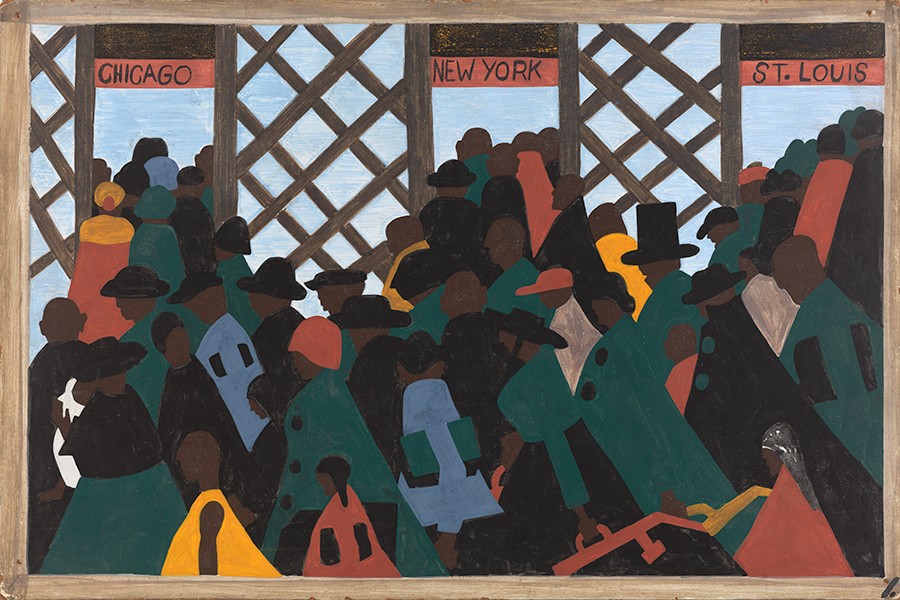Hum 110 Moves to Harlem
Prof. Pancho Savery lectures on the art and politics of the Harlem Renaissance.
The final unit of Humanities 110 is underway, and it got off to a historic start with a lecture by Prof. Pancho Savery [English 1995–]. “Welcome to the final module on Harlem, the black capital of the universe,” he began.
In the fall, Hum 110 concentrated on Athens and the ancient Mediterranean. This spring, for the first time in the course’s history, it has included texts from the Americas, focusing on Mexico City and New York City. Unlike previous units, which covered vast swaths of time, “Aesthetics and Politics: Harlem” will focus on just sixty years, with most of the texts sourced from the period known as the Harlem Renaissance.
Scholars debate the dates of the Harlem Renaissance, but Prof. Savery pins the starting point to the year 1919, when a ship landed in New York with members the 369th Infantry Regiment—African American fighters returning from World War I. Before the war there had been a lot of discussion in the black community about whether people should go to Europe and fight. Some felt African Americans had no business fighting for freedom abroad when they weren’t yet free in the United States. Others argued that if African Americans fought bravely for the United States, they would prove to white America that they were worthy of full citizenship.
“When the soldiers came back they landed and they marched up Fifth avenue to Harlem," he said. "My maternal grandfather was one of those soldiers.”
The soldiers returned with a new attitude of militancy. They’d fought in France and had been treated like human beings there—which was not how they were treated in the United States. This, Prof. Savery pointed out, was one of the causes of the Harlem Renaissance.
His lecture “Strange Fruit” explored some of the other causes, beginning with the Dred Scott decision, the 15th Amendment, Jim Crow laws, the rise of the Ku Klux Klan, the failed promise of Reconstruction, and lynchings of African Americans throughout the South.
Students read Southern Horrors: Lynch Law in All Its Phases by Ida B. Wells, an investigative reporter and newspaper owner in Memphis who was born a slave. When three of her close friends were lynched, she decided to investigate the facts surrounding the cases. The overwhelming majority of lynchings charged a black man with raping a white woman. And in an overwhelming majority of cases, the charges were not true. Lynchings were a disturbingly common public spectacle. People came from all around to see them. They brought their children. They took photos and put them on postcards and sent them to friends. Prof. Savery noted that three months ago, in December 2018, Congress made lynching a federal crime.
Wells came to the conclusion that lynching was an act of terror by white supremacists to maintain the oppression of African Americans. She organized a bus boycott in Memphis to protest lynchings, and used tactics that would later be deployed by Dr. Martin Luther King in Montgomery.
Students also read “The Atlanta Exposition Address” by Booker T. Washington. Washington did not take Wells’s head-on approach to the conditions of African Americans in the South. He argued that it was a mistake for African Americans to seek political power, but instead should do and make things with their hands. He founded the Tuskegee Institute and became the most prominent black man in the country.
Conditions for African Americans did not improve in the South. The beginning of the twentieth century saw what came to be known as the Great Migration: millions of African Americans left the intolerable conditions of the South for the North, many settling in Harlem to fill factory jobs vacated by workers who had gone to Europe to fight in the war.
As African Americans settled in the North, white people became interested in things connected to black people, and this was also a contributing factor to the Harlem Renaissance. They went to Harlem to listen to jazz. Writers like Eugene O’Neill used black characters in fiction. Picasso and Matisse used motifs of African art in their art. Gershwin and Stravinsky and Dvorak used African American rhythms in their music.
Prof. Savery invited students to consider how the Harlem Renaissance was an assertion of African American citizenship through art. He referenced a quotation by James Weldon Johnson in his preface to The Book of American Negro Poetry that “no people that has produced great literature and art has ever been looked upon by the world as distinctly inferior,” and he asked students to think about whether this is true, and if so, was the Harlem Renaissance a success? And if not, why not?
He concluded the lecture with a piece of music. In 1937, he said, the same year that Zora Neale Hurston published Their Eyes Were Watching God, a New York City school teacher named Abel Meeropol, haunted by a photograph of a lynching, wrote a protest poem. (Meeropol, it should be noted, later adopted the orphaned children of Ethel and Julius Rosenberg who were tried and executed for espionage.) Meeropol’s poem was set to music, and the piece was named “Strange Fruit.” The lecture hall filled with the mournful voice of Billie Holiday, accompanied at first only by a simple minor harmony in the piano’s lowest registers. “Southern trees bear a strange fruit. Blood on the leaves and blood at the root.” The word “lynching” does not appear in the song’s lyrics, but it vividly evokes its horrors. Holiday’s performance attests to the greatness and the power of a quintessentially African American art form—jazz.
